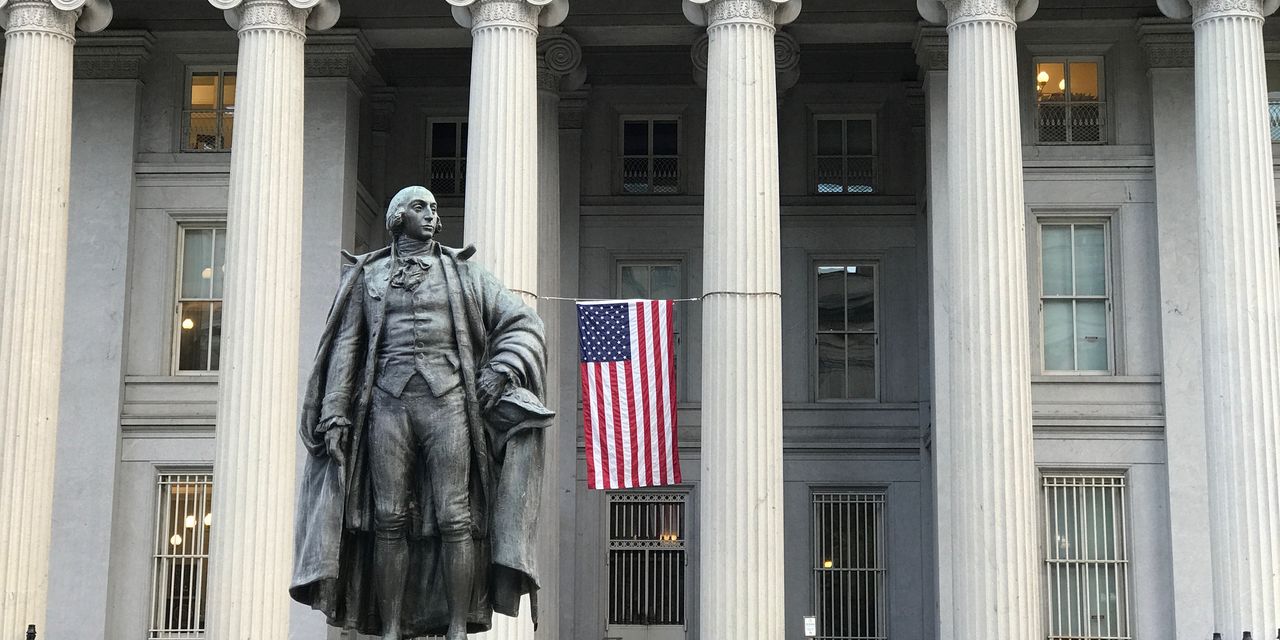Heavy U.S. government borrowing is in focus this week, with the potential to take investors’ attention away from the Federal Reserve’s policy update on Wednesday.
One big reason is that the Fed is widely expected to remain on hold, with fed funds futures traders pricing in little chance of additional central-bank action this week or by year-end. Another is that the U.S.’s fiscal trajectory is seen as an important factor behind the recent run-up in long-term Treasury yields, which sent the 10-
BX:TMUBMUSD10Y
and 30-year rates
BX:TMUBMUSD30Y
to 16-year closing highs earlier this month.
Investors are demanding more compensation for the risks of holding government debt to maturity, while the Fed’s rate-hiking cycle so far has increased the cost of interest on that debt. The ongoing surge in bond yields has become a bigger story than the Fed’s two-day meeting which ends on Wednesday, with Fed Chairman Jerome Powell expected to simply reiterate a message of higher-for-longer rates, according to Eric Sterner, chief investment officer at Apollon Wealth Management.
Treasury yields broadly jumped on Monday ahead of a 3 p.m. Eastern time announcement by Treasury of its fourth-quarter financing estimate. That’s set to be followed in two days by the department’s quarterly refunding statement and details of upcoming auction sizes.
“With the Fed expected to remain on hold this week, market participants are focusing on the Department Of Treasury’s quarterly refunding announcement,” said Gregory Faranello, head of U.S. rates for AmeriVet Securities in New York. “This is a time for the government to announce financing plans and needs in the months ahead with a focus on the retiring of existing debt and raising of new cash.”
What has the bond market so nervous is that the government is running large deficits at a time of robust growth in the U.S. economy, when it should actually be shrinking those deficits, some say. At the moment, the government has spent roughly $1.7 trillion more than it has collected in revenue for the fiscal 2023 year between October 2022 and September of this year.
Treasury uses the refunding process, based on calendar quarters, to spell out its borrowing needs and detail its plans for note and bond auctions. It begins by first gathering advice from primary dealers, as well as its own Treasury Borrowing Advisory Committee. Then, any changes in the department’s debt-management policy, based on that advice and its own analysis, are announced through quarterly refunding statements and made public by a Treasury official.
The department shocked the bond market on July 31, with a $1 trillion borrowing estimate for the third quarter that was much higher than what it had expected in May. This time around, Wall Street firms like Deutsche Bank
DB,
and JPMorgan
JPM,
are bracing for what could be $749 billion to $800 billion of borrowing for the fourth quarter, and, after including estimates for the first quarter of 2024, might add up to a total of roughly $1.5 trillion through early next year.
In general, “we are running outsized deficits for an economy at full employment,” AmeriVet’s Faranello wrote in an email to MarketWatch on Monday. “This has market participants concerned … The focus will be on overall cash needs and then where the Department of Treasury chooses to emphasize issuance on the curve.”
The financing estimate released on Monday is expected to provide the market with a broad overview of the amount of borrowing needed for the months ahead. In July, Treasury had estimated that it would need to borrow $852 billion in privately held net marketable debt between October and December, assuming an end-of-cash balance of $750 billion.
On Wednesday, Treasury is expected to release another round of documents, including a policy statement from a department official, input from the Treasury Borrowing Advisory Committee and an auction schedule identifying the amounts and dates of upcoming sales broken down by maturities.
An auction that goes well has the potential to ignite buying of government debt generally, which was the case last Thursday when a solid $38 billion sale of 7-year notes led to an extended rally. Conversely, soft auctions met with lackluster demand can reinforce selling, as happened in August after the market struggled to absorb a $23 billion auction of 30-year bonds.
The continued onslaught of supply from Treasury has raised questions about whether U.S. and foreign buyers can continue to keep up demand for government debt. One issue that’s been raised is whether the absence of large buyers insensitive to underlying prices, like the Fed, might lead to a period where demand dries up — pushing yields even higher.
Ten- and 30-year yields have each jumped more than a full percentage point from where they were in April. On Monday, they continued to go higher, with the 10-year trading around 4.9% and the 30-year rate at 5.06% during the New York afternoon.
Some economists said higher yields are doing part of the Fed’s job of tightening financial conditions and that the term premium, or additional compensation that investors are seeking, might even be worth two or three rate hikes alone.
“Fiscal spending has gotten out of hand and is not sustainable, especially now with higher interest rates and the additional cost of interest to pay for those large deficits,” said Sterner of Apollon Wealth Management, which manages $5.3 billion from Mount Pleasant, S.C.
“With the economy growing and unemployment near historic lows, this is a time when we should be cutting deficits, but instead we are adding to it,” Sterner said via phone. “If the economy potentially slips into a recession next year, the Fed and the government aren’t going to be in a position to provide stimulus or cut rates as they have in the past due to these large deficits and stubborn inflation. It’s concerning that the deficit is growing in a higher interest-rate environment, and also at a time when we are trying to fund two wars [in Ukraine and the Middle East] with no end in sight.”
Read the full article here











Leave a Reply